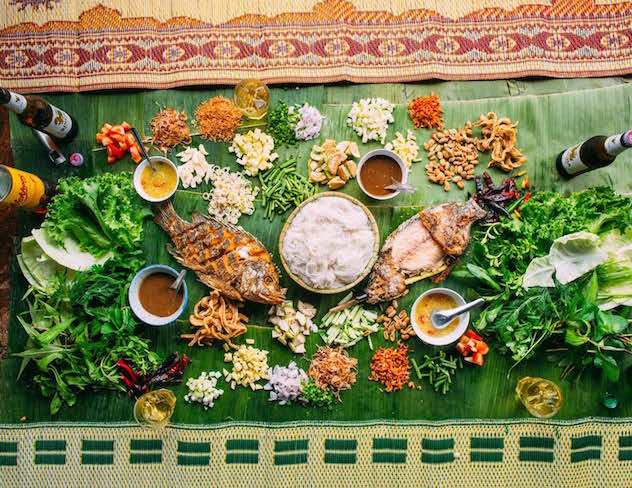In 2011, James Syhabout took over the family business — his mother’s Thai restaurant in Oakland — and transformed it into his now-famed Lao/Thai eatery, Hawker Fare. Syhabout was already a rising star, having made his bones in Michelin-starred restaurants like Manresa and Commis, but with Hawker Fare, he saw an opportunity to rediscover his Lao American roots. His recent book, “Hawker Fare,” co-written with John Birdsall, is a memoir/cookbook and also, in his own words, “an apology letter, an attempt at reconciling my past.”
Many other Asian American chefs have chronicled life journeys that first lead them away and then back to the food of their heritage, but Syhabout is also writing about the trauma of memories and histories lost to war. He was only 2 when the lingering fallout of the Vietnam War led his family to leave their home province of Isaan, in northern Thailand. As refugees, they eventually landed in the Bay Area. His mother, tirelessly running hole-in the-wall Thai restaurants, kept the family afloat for years. Shyabout grew up in her kitchens and, upon graduating high school, went to culinary school. His career path seemed aimed toward fine dining until his mother told him she was ready to call it quits after 25 years in the food business. That’s when Syhabout decided to step in.

James Syhabout (Photo Nader Khouri)
“Hawker Fare” traces Syhabout’s return to Lao cooking — and Laos itself — but it’s also a primer about Lao society, culture and history, topics that most Americans know little about. As he writes, this is partially because for decades the Lao, and their food, have passed for Thai. “It’s just easier,” Syhabout admits.
Indeed, most Americans who’ve ever had Thai food have likely sampled Lao-influenced cuisine without knowing it: Ever order sticky rice or green papaya salad? As “Hawker Fare” explains, waves of ethnic Lao, a.k.a. “Lao Isaan,” moved to Thai cities such as Bangkok beginning in the 1970s. That influx reshaped Thai cuisine, not unlike how Latinx migrants have transformed American food traditions.
When Thai restaurants gained a foothold here by the ’80s, many imported those Lao influences, but American diners had no knowledge of the dishes’ traditional backgrounds. Ironically, even though the Lao population here is larger than the Thai, the popularity of Thai food has given the Thai community a far higher visibility. Even Syhabout, when he first opened Hawker Fare, described it as a “Thai Isaan” eatery. It’s only more recently that the restaurant, now in San Francisco’s Mission District, bills itself as being “Lao Isaan.”
To be sure, the differences between the cuisines aren’t massive. Syhabout invokes a common Lao saying, “same same but different,” since both have a sweet-sour profile, but he clarifies that the “Lao cuisine favors umami. The flavors are salty, bitter and herbaceous.” Think duck laap, the popular minced meat salad that most Americans know as “larb,” which he makes with generous doses of lemongrass, shallots, mint and cilantro, or dtom keung nai kwuay, a beef soup heavy with offal, bile and fermented fish sauce.
“Hawker Fare”’s nearly 100 recipes dwarf what’s served in the restaurant, though he includes menu favorites, such as his mom’s phat prik khing: green beans blistered in oil then wok-fried with bacon, curry paste and kaffir lime leaves. Syhabout insists his “is the furthest thing from an authentically Thai or Lao book,” but it’s obvious he wants to showcase a diversity of traditional Lao foods. For example, he includes over half a dozen laap recipes, the most palate-challenging being one made with raw beef tripe, liver and sirloin. Personally, I plan on trying the som moo tawn recipe that uses pork jowl — one of my favorite Isaan ingredients — fermented overnight with salt, sugar, garlic and MSG (yes, MSG) before a pan-fry finish.
However, as I’ve said about other restaurateur cookbooks, “Hawker Fare” may pose challenges to mere mortals at home. The ingredient lists can be daunting given the fresh herbs and specialized sauces you’re meant to have on hand. Likewise, Hawker Fare is known for its deep-fried snacks. I’ve enjoyed their rice flour-battered fried chicken, tossed with a tamarind-spiked chile jam (gai tod naam prik pao). But unless you own a deep fryer and are comfortable with using quarts of oil, it may be best to just wait until your next Bay Area visit.
Of course, Syhabout wasn’t aspiring to pen “Lao Food For Dummies.” The book’s core mission is less about the recipes and more about bringing awareness to Lao communities and, by extension, their contributions to American food culture. After decades of social invisibility, chefs like Syhabout, Washington, D.C.’s Seng Luangrath and Raleigh’s sibling team of Vansana and Vanvisa Nolintha are helping shape a future where Lao food need not hide in plain sight any longer.
Oliver Wang is a professor of sociology at CSU-Long Beach and writes on music, food and culture.
This article appears in KORE’s December 2018 issue. Subscribe here.







